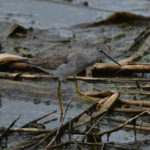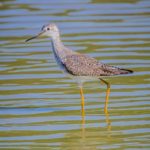July Bird of the Month is the Lesser Yellowlegs, and here is the article in the July-August Kite written by Ben Kolstad.
In May we concluded our profiles of the sandpipers in the genus Calidris (aka “the peeps”). In June we began our discussion of the genus Tringa, starting with the largest of the shorebirds in the genus: the Willet. This month, we’ll look at a much more vexing ID, the look-alike Lesser and Greater Yellowlegs. Where the Willet is stout (legs and bill), these two birds are much less so. And while the Greater Yellowlegs (Tringa melanoleuca) is closer in size to the Willet, the Lesser Yellowlegs (T. flavipes) is actually more closely related to the Willet than it is to the Greater Yellowlegs! (This might remind you of Hairy and Downy woodpeckers, two very similar-appearing but only distantly related members of the family Picidae.)
VOICE: Perhaps the best way to tell the two yellowlegs apart is to listen to their call: the lesser bird has the lesser call. A flat tu-tu is the most frequent call of the Lesser Yellowlegs, while a rather more musical three (or four or more) note tu-tu-tu is the cry of the Greater Yellowlegs.
BEHAVIOR: Lesser Yellowlegs tend to feed more calmly, with less thrashing about and darting, than Greater; they’re also less skittish and will tend to stick around long after the nervous Greater Yellowlegs has taken off, leaving behind only its longer, more musical call notes.
GISS: Of course, the overall impression of the birds, when seen together, is that the Greater Yellowlegs is a larger, more robust bird, with longer legs, longer bill, etc. But it’s not too useful when you don’t see the two together.
FIELD MARKS: However, bill length relative to the head works even when you have only one species in front of you. And here, just as with the call, the greater bird has the greater bill: a bill clearly longer than the head and slightly upturned toward the tip marks the Greater Yellowlegs, while a shorter, straighter, needle-like bill about as long as the head itself gives reasonable identification of the Lesser Yellowlegs. There are some subtle plumage differences as well, but since they change with the seasons, while call pattern and bill length don’t, they’re a bit harder to keep in mind. (In breeding plumage, the greater yellowlegs has darker barring on its flanks.)
In any event, sorting out the yellowlegs is one of the more interesting challenges among the larger shorebirds in our local wetlands and marshes.
(Photographer’s please note that next month’s August 2016 Bird will be the Greater Yellowlegs)
- Lesser Yellowlegs by Don Davis
- Lesser Yellowlegs at Peaceful Waters by Paul Thomas
- Lesser Yellowlegs at Peaceful Waters by Paul Thomas
- Pair Lesser Yellowlegs at Peaceful Waters by Paul Thomas





Comments are closed